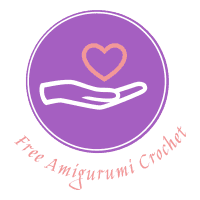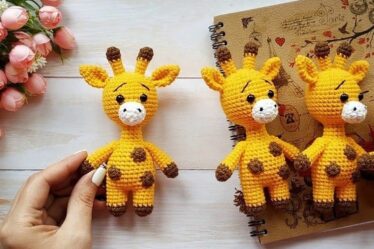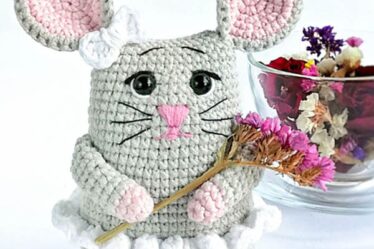Hello dear Amigurumi Followers
Today we share Amigurumi Horse of Cauca Free Pattern for you. As you know we share new free amigurumi pattern every day. The main crochets are gazelle, amigurumi bear, pola, crochet panda, penguin, giraffe, llama, pig, bunny, clown, lamb, bee, crochet unicorn, amigurumi doll, fox, penguin, dinosaur, crochet elephant, hippo, monkey, crochet cat, crochet dog and more …
Todays daily new amigurumi free crochet pattern is Amigurumi Horse of Cauca.
I want to give you some informations about this amigurumi free pattern ; Horse of Cauca.

We are preparing a hook No. 1.75 or No. 2, suitable for him yarn.
Decide on the color scheme yourself – Horses are different – black, white, red!
The main thing for the tail and mane is to find the right shade so that the combination is harmonious.
The wire is needed in isolation, 4mm thick – who knit a blotter, he knows – the same.
A piece of white knitwear (an old T-shirt, or a T-shirt, or … but we will not tell anyone about this)
Acrylic paints or special dyes for fabric.
Oil paint shade suitable for the color of yarn, which will knit the horse itself.
Oil paint should be darker than the base color, the color of the yarn.
Filler, of course.
So let’s go!
Amigurumi Horse of Cauca Free Pattern
We start knitting horses with the details of the body
1p.6
Sat 2r.6 times increase = 12
3p.6 times (increase, 1Sbn) = 18
4p.6 times (2Sbn, increase) = 24
5p.1Sbn, increase, 5 times (3Sbn, increase), 2Sbn = 30
6p.6 times (4Sbn, increase) = 36
7p.2 Cbl, increase, 5 times (5Bs, increase), 3Sbn = 42
8r.42Sbn
9r.6 times (increase, 6Sbn) = 48
10р.48Сбн
11р. 6 times (increase, 7Сбн) = 54
12р. 54 Sat
13r.6 times (increase, 8 Sat) = 60
14-18 p . 60 Sat
19r.4 times (decrease, 3 Sat), decrease, 38 Sat = 55
Sat 20-22 p.55 Sat
Align the beginning of the row relative to the beginning of the second row of knitting – move forward, tying required for this amount
This number is determined visually, the total number of loops does not change during this maneuver.
23r. 5 times (decrease, 3Сбн), 30 Сбн = 50
24-26р. 50 Sat 27r .
Attention!
This series should start from the beginning of reductions in the previous rows. Therefore, again move the start of knitting.
Again, this is determined by the eye.
5 times (decrease, 4Cbn), 5 Cbd = 45
28p.45 Cbn
29r.5 times (decrease, 7x) = 40
30r.40 Cbn
Bite off a wire about 20-21 cm long.
Bend it arc.
Determine the place of growth of the hind legs.
To do this, we first determine where the back of the horse is, where the tummy is – the back is slightly arched, the tummy, on the contrary, is convex.
Then you need to determine the middle of the back and abdomen, so that the legs are in the lower part of the body, and not somewhere on the side.
The center can be marked with a marker – a contrasting thread, for example.
The holes for the legs are made by widening the distance between the hook and the knitting needle. Holes should be quite small – on the diameter of the wire.
You need to arrange them between 12 and 13 rows.
Between them there should be about 18 Sbc, if we count on the 13th row.
31р.5 times (decrease, 6Сбн) = 35
32р.35Сбн
Fill the back part of the body, evenly distributing the filler around the frame.
The frame itself, or rather the upper part should be at a distance of 1 cm from the knitted fabric.
Bend the second wire for the front legs.
We also verify the distance and make holes for the frame, place them between 26 and 27 rows.
When viewed from the side, the front and rear legs should be almost in line.
The edge of the arc of the frame should rest against the knitted fabric.
Fill the space around the frame of the front legs with filler, properly tamping it.
33r.6 times (decrease, 5Сбн) = 30
34р.6 times (decrease, 3 Сбн) = 24
Fill the rest of the body
35р.6 times (decrease, 2 Сбн) = 18
36р.6 times (decrease, 1 Сбн) = 12
37р. 6 decreases = 6
Pull down the hole, before that add some filler if necessary.
At the ends of the wire twist the small loops and bend them forward in the shape of the foot.
As a result, at this stage, the legs should be about 5 cm long.
Getting to the hooves.
1р.6Сбн
2р.6 times increase = 12
3р.6 times (increase, 1Сбн) = 18
4р.6 times (2Сбн, increase) = 24
5р.24Сбн for the back wall of the pigtail
6р.24Сбн
7р.6 times (2Сбн, diminishing ) = 18
8р.6 times (decrease, 1Сбн) = 12
Instead of the last Cbn, we knit Cc, in which we change the color of the hoof to the main color of the horse.
9r. 6 decreases
After the first reduction is completed, cut off the thread that knitted the hoof and tie this tip firmly on the two knots together with the tip of the thread of a new color.
After two or three reductions of the 9th row, insert the frame and fill the hoof, distributing the filler evenly around the frame.
After finishing the row, fix and cut the thread, leaving a long tip for the subsequent winding of the leg.
Thread the tip of the thread into the needle and tighten the part around the frame.
Wrap the wire double-sided tape.
Who has no scotch, try to use Moment – Crystal glue.
Try to apply a thin layer of it.
We wind wire with thread.
Repeat the same with the rest of the legs.
Begin to knit a snout 11 rubles. A chain of 10Vp – jumper, hook hook into the 19th loop in a circle, 15Sbn, reaching the chain, 10Sbn (1Sbn in each loop of the chain, behind the back wall of the pigtail) = 25
12r.25Sbn
13r.The addition , 11Sbn, decrease, 10Sbn = 23
14р. Decrease, 9Sbn, decrease, 10Sbn = 21
15-17r.21Sbn 18r.10
times addition, 11Sbn = 31
19-24r.31
25r.5 times (decrease, 4Sbn), 1Sbn = 25
26r.5 times (decrease, 3Sbn), 1SBN = 19
27р.5 times (decrease, 2Сбн), 1Сбн = 13
28р.5 times (reduction, 1Сбн), 1Сбн = 7
29р.5 decrease.
Fasten the thread, cut, pull the hole.
Fill the muzzle.
Getting to the neck knitting.
From the main part we have 18 loops left + 10 loop chain = 28 loops.
On these loops we will knit the neck.
We attach the thread to the 10th Sbn of 18 – this will be the beginning of the series.
Knit in a spiral.
1p.1Vp lifting, 1Sbn in the same loop, from which raised Bp – this is one element, the first Cbn in a row, 7Cbn, a decrease (one of the reduction tables falls on a head detail, the second on a column, which is knitted on a jumper), 8Cbn, decrease (in the same way as the first), 8Сбн = 26
2p.8Sbn, Gaunt (one column in the decrease of the previous row, second to the column jumper), 6Sbn, Gaunt, 8Sbn = 24
3p.8Sbn, Gaunt, 4Sbn, Gaunt, 8Sbn = 22
4р. 8Sbn, increase, 2Sbn, increase, 8Sbn = 20
5-10r.20 11
p.2 times (1Sbn, increase), 12Sbn, 2 times (increase, 1Sbn) = 24
12-15r.24Sbn
16p.2raza (2Sbn, increase), 2Sbn, 2Psn (polustolbik with sc) 4Ssn (column with sc) 2Psn, 2Sbn, 2 times (gain, 2Sbn) = 28
17r.7Ss, 3Sbn, 2Psn, 4Ssn, 2Psn, 3Sbn, 7Ss = 28
thread fasten and cut , leaving a long tip for later sewing parts to the body.
We pin the head to the body with pins, so that the extreme point of the neck under the head touches the last straightened row of the body.
We sew parts – one short stitch behind the body, one for the closest wall of the pigtail, we sew a seam by analogy with lacing, carefully tightening each stitch.
Ears
Chain 8Vp + 1Vp lifting
1p.7Sbn, 3Sbn to the last loop of the chain, 7Sbn. Knitting in a circle does not close, rotate.
2p.1Vp, in the same loop, from which they just raised the Bp, knit 1Sbn, 4Psn, 5Sbn. Turn.
3r. 1Bn + 1Sbn to the same loop, 8Sbn, 2Sbn to the next loop.
Fasten the thread, cut off, leaving a long tip, nudge it into a needle and tilt along the seamy side to the base of the ear.
Fold the eyelet in half lengthways and grab both sides together for 0.5 cm from the base with several stitches.
Fasten the thread, cut off, thread the tip of the thread into the needle, carefully thread it to the base and sew the ear to the head part, previously pinned with pins.
Tail
1R. In the ring amigurumi 8Sbn 2-7p.8Sbn
We cut the yarn into segments of approximately 16-17cm.
It will be convenient if you pick up any suitable template.
I have this time made a notebook.
The yarn is wound on this pattern, then cut at one point – we get segments of threads of the same length.
And the tail and mane need segments of the same length, so we prepare everything at once.
With the help of a hook (you can take a size smaller than the one that was knitted), the yarn clings to the tail, according to the principle of fringe.
The photo shows the direction of introduction of the hook into the canvas and the direction of the thread, which we insert relative to the hook and details.
Ready tail sew to the body between 11 and 13 next to the start of knitting.
Mane
From ears to withers we outline the line of growth of the mane.
If you have a dark yarn, you can use a remnant, if light – a simple pencil or gel pen, for example (in the second case – do not be particularly zealous).
The line will be closed with a yarn, but nevertheless try to hold it neatly.
Attach the mane.
Again, pay attention to which way we are introducing the hook, hooking the thread so that the growth line is neat.
Tighten each thread attached securely.
Having finished with a mane, we begin to increase a bang.
For this, we also designate a bang area in a contrasting line.
Starting from the ears, attach a few threads, sticking a hook in the same direction that you stuck in the mane – send these strands behind the ears.
The following rows begin to build in the direction of the face, respectively, stick the hook in the opposite direction. Threads need to be attached to each column and row so that there are no bald spots.
Now all this lush vegetation needs to be cut. Bang leave a length of approximately to the middle of the face.
To trim the mane, turn the horse upside down and trim the mane so that all the threads are the same length.
It is desirable that the mane lowered on its side does not cover the beginning of the growth of the front leg.
Trim the tail too.
So that the bang does not stick out, it can be slightly moistened and tied with a thread before drying.
You can do it later, after the eyes are sewn.
Eyes
For the eyes, we need to cut a circle with a diameter of 3.5 cm from a piece of white knitwear.
Seam over the edge of this circle.
Before you finally pull off the circle, fill it, slightly flattening, and fasten the thread.
The thread is not cut off.
We overtighten the ball in the center with two turns, fasten the thread.
Then we take the black bobbin thread and also separate the eyes with two turns.
Sew the white coil thread eyes to the muzzle, pre-fixing them with a pin.
On the sewn eyes, gently draw the pupils with black acrylic paint, set the glare with white paint.
I use a toothpick for this. Nostrils also draw in black.
Paints, by the way, are better suited for acrylic fabrics.
Although the usual can also be used.
Smile We
embroider a smile with a thin black thread.
I have this thin wool thread for embroidery. A smile is one stitch well stretched in an arcuate shape.
At the edges of the smile – short stitches for greater expressiveness.
Toning
Now we are starting to tint the horse so that it becomes more interesting and effective.
We take oil paints.
It is advisable to take the color on the tone darker about the color of the yarn. At first I thought that black could be useful, but then I stopped at Koput-Mortuum dark.
So he is some kind of brown-maroon.
Squeeze out a little paint on a napkin or paper towel to absorb excess oil.
Then with a stiff brush, it will need bristle, take quite a bit of paint and begin to make strokes on the paper until these strokes become barely noticeable.
Now we are starting to put a tone on our Tsatsu.
It is advisable to highlight the area of the back, croup, the beginning of the growth of the legs and the legs themselves – the upper part.
Shade a little face and cheekbones – be careful, do not touch the white eyes.
Now our Swell is ready!



